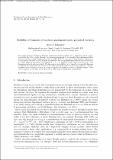Files in this item
Stability of filaments of uniform quasi-geostrophic potential vorticity
Item metadata
| dc.contributor.author | Reinaud, Jean N. | |
| dc.date.accessioned | 2021-01-27T00:37:05Z | |
| dc.date.available | 2021-01-27T00:37:05Z | |
| dc.date.issued | 2020 | |
| dc.identifier | 264281373 | |
| dc.identifier | bfcc7406-9458-4226-a807-3e1a0c1bcaef | |
| dc.identifier | 85078449888 | |
| dc.identifier | 000509459100001 | |
| dc.identifier.citation | Reinaud , J N 2020 , ' Stability of filaments of uniform quasi-geostrophic potential vorticity ' , Geophysical and Astrophysical Fluid Dynamics , vol. 114 , no. 6 , pp. 798-820 . https://doi.org/10.1080/03091929.2019.1704752 | en |
| dc.identifier.issn | 0309-1929 | |
| dc.identifier.other | ORCID: /0000-0001-5449-6628/work/68281500 | |
| dc.identifier.uri | https://hdl.handle.net/10023/21329 | |
| dc.description.abstract | We analyse the linear stability of filaments of uniform potential vorticity with a horizontal axis in a quasi- geostrophic flow. For a single filament, the situation corresponds to the simplest three-dimensional shear zone in a rapidly rotating, continuously stably stratified fluid. Yet, this has not been formally addressed to our knowledge. We show that the filament is sensitive to the Kelvin-Helmholtz instability for perturbations in a finite range of streamwise wavenumbers 0 < k < kc, similarly to the classical situation of a two- dimensional strip of uniform vorticity. We also analyse the stability of a jet formed by two parallel filaments of opposite PV whose axes are located on the same horizontal plane as well as the stability of "hetonic" filaments. Hetonic filaments consist of a pair of opposite PV filaments located at different heights. These can be sensitive to baroclinic instabilities over a wide range of longitudinal wavenumbers. | |
| dc.format.extent | 21 | |
| dc.format.extent | 12451609 | |
| dc.language.iso | eng | |
| dc.relation.ispartof | Geophysical and Astrophysical Fluid Dynamics | en |
| dc.subject | Vortex dynamics | en |
| dc.subject | Quasi-geostrophy | en |
| dc.subject | QA Mathematics | en |
| dc.subject | T-NDAS | en |
| dc.subject.lcc | QA | en |
| dc.title | Stability of filaments of uniform quasi-geostrophic potential vorticity | en |
| dc.type | Journal article | en |
| dc.contributor.institution | University of St Andrews. Scottish Oceans Institute | en |
| dc.contributor.institution | University of St Andrews. Applied Mathematics | en |
| dc.identifier.doi | https://doi.org/10.1080/03091929.2019.1704752 | |
| dc.description.status | Peer reviewed | en |
| dc.date.embargoedUntil | 2021-01-27 |
This item appears in the following Collection(s)
Items in the St Andrews Research Repository are protected by copyright, with all rights reserved, unless otherwise indicated.

